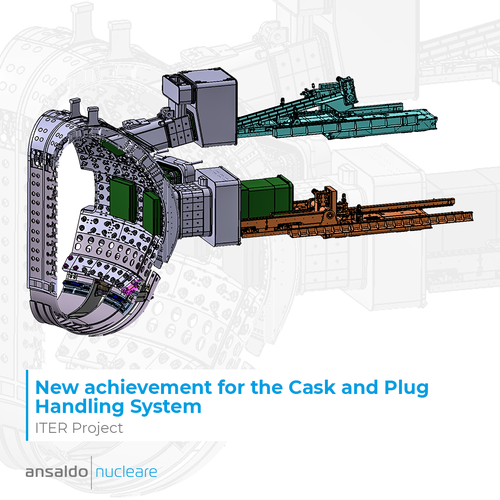Design approved for ITER Cask and Plug Remote Handling System

Illustration of the ITER Cask and Plug Remote Handling System, with the Upper Port Plug and Equatorial Port Plug. F4E and Ansaldo Nucleare have been collaborating for the Final Design Review of the system. April 2022. ©Ansaldo Nucleare
ITER will rely on Remote Handling systems to transport, maintain and replace heavy components exposed to radiation. Sophisticated devices with specifically designed tooling, virtual reality, and man-in-the-loop applications will allow engineers to perform these tasks without people entering into the ITER device. Europe is responsible for four of the six Remote Handling systems, with one of them designed for the handling and transport of port plugs.
Let’s start by clarifying that ITER plugs have nothing to do with those we use at home. A total of 14 port plugs at the Tokamak equatorial level, and 14 at the upper level, will host diagnostics, some of the ion and electron cyclotron heating systems equipment, and test blanket modules. The plugs will be transferred in and out of the machine with double door containers, known as casks.
According to current estimates, 15 of these casks will need to be manufactured and in their largest configuration they will measure 8.5 m x 3.7 m x 2.6 m, approaching 100 tonnes when fully loaded. These enormous stainless steel “boxes”, resembling a conventional freight container, will be remotely operated to move between the different levels and buildings of the ITER machine.
F4E in collaboration with, Ansaldo Nucleare, ITER Organization, and experts, have successfully concluded the first final design review of the Cask and Plug Remote Handling System. It is fit for purpose for the ITER machine assembly phase, taking into consideration the knowledge acquired during the preliminary design review. What is novel in its case? Essentially, it is simpler to operate and focused only on the functionalities needed for the ITER assembly phase. For example, the system can be operated in full-manual or semi-manual modes. The panel of experts has put emphasis on manufacturing and its capacity to fulfil its role during assembly. For example, some of these plugs will be delivered to the Assembly Hall and from there they will be transported either to the galleries of Level 1 of the Tokamak building, or to galleries of Level 2 along a path of 300-400m.
Towards the end of this year, a contract is expected to be signed for the manufacturing of three machines i) the vehicle to transport the port plugs through the ITER buildings, ii) a machine for the installation of an equatorial port plug, iii) a machine for the installation of an upper port plug. The delivery date of these systems is scheduled for 2026.
Caroline Dremel, Technical Project Officer working for F4E’s Cask and Plug Remote Handling System explains, “This important milestone was achieved with a truly collaborative spirit between F4E, Ansaldo Nucleare, ITER Organization, and our experts. During the two sessions that we held in discussing the final design, we highlighted the importance of flexibility in designing these components to accommodate any adjustments needed during their operation. Similarly, given the fact that these pieces of equipment will be used for the assembly phase of the device, we wanted to be practical, while meeting all technical parameters.”